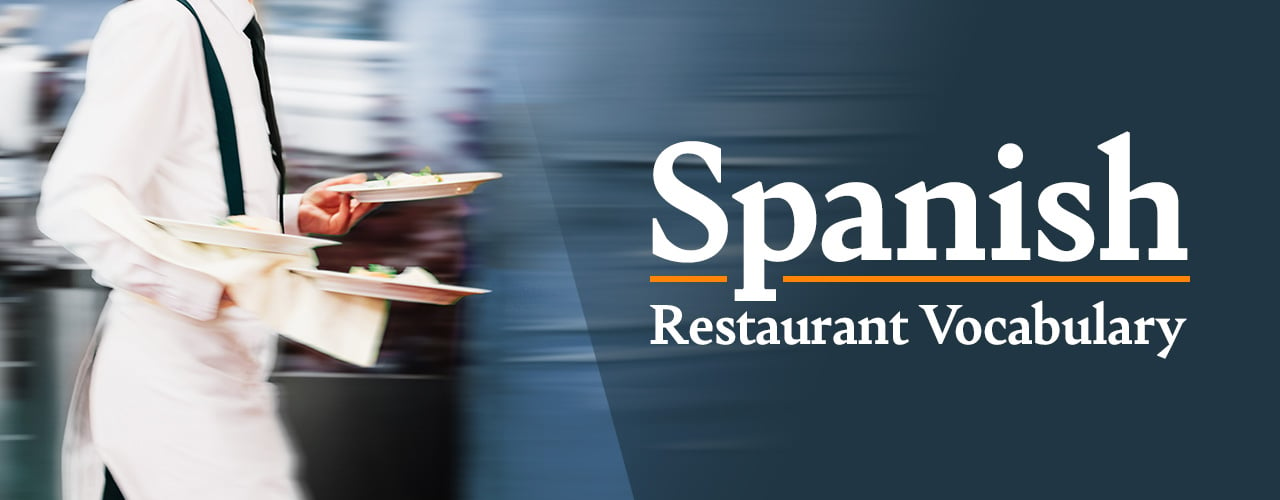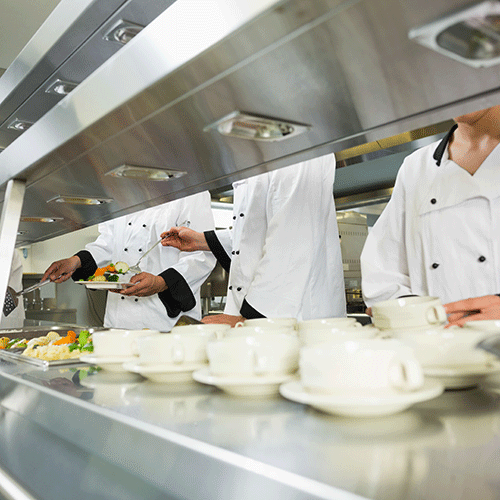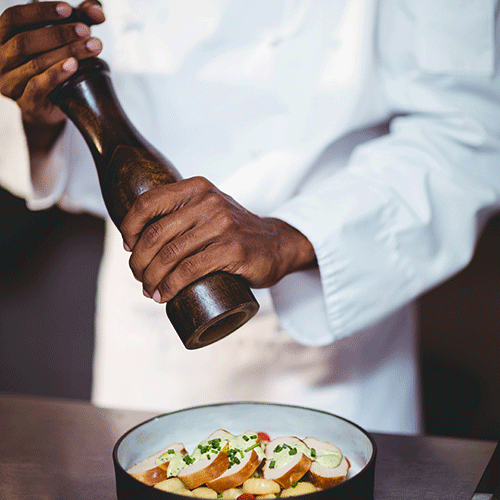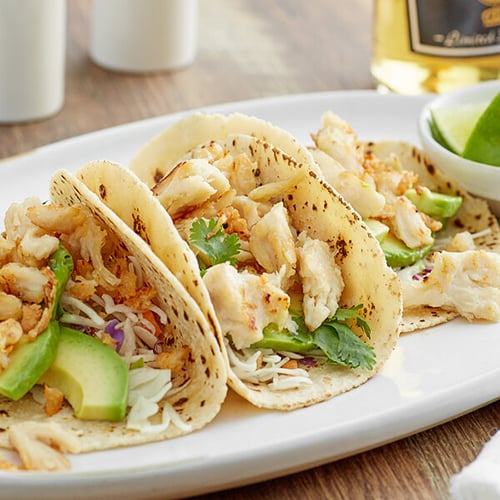
A foodservice kitchen is a bustling environment, often with a diverse group of people filling an array of restaurant roles and responsibilities. Because of the number of employees needed to ensure a kitchen operates smoothly, it is not surprising that many restaurant businesses regularly encounter a language barrier between staff members. Spanish is one of the most widely spoken languages in the foodservice industry after English, so teaching your staff Spanish restaurant vocabulary can help create a more efficient and inclusive work environment. We have compiled a list of the most common Spanish phrases to share with your restaurant staff that can help improve communication overall. Check out our printable restaurant Spanish vocabulary sheet below.
Spanish Restaurant Vocabulary
Check out our video to learn some commonly used Spanish restaurant phrases:
Importance of Restaurant Spanish

Per the Bureau of Labor Statistics, 25.9% of restaurant industry workers in the U.S. are Hispanic or Latino. With such a high percentage, most restaurants in the nation will likely employ at least one Spanish-speaking worker at any given time.
The following are just some of the reasons why it is important to teach your staff Spanish kitchen words and phrases:
1. Workplace Inclusivity
A language barrier can cause employees to feel excluded from both casual and important conversations in a work setting. Even if someone is bilingual, it can be frustrating to struggle to find the right words to communicate. When English-speaking staff members learn kitchen Spanish phrases, it creates a mutual connection between employees and reduces the number of times a Spanish speaker may flounder looking for ways to communicate with their peers.
2. Create a Learning Environment
When your staff members are dedicated to learning kitchen Spanish words, your Spanish-speaking employees will have the opportunity to teach those around them. This will also allow them to feel more comfortable learning English with each staff member working towards bettering their vocabulary, comprehension, and pronunciation. This creates a more forgiving environment where each person is safe to make mistakes and has permission to struggle while learning a new language.
3. Reduction of Miscommunications and Errors
A kitchen is a fast-paced environment and it is easy for miscommunication to occur, even when everyone speaks the same language. A language barrier can be the source of incorrect orders, kitchen accidents, and daily stress. When you teach kitchen Spanish, you keep your staff on the same page, improve the flow of overall communication, and reduce the potential for errors.
4. Team Building and Trust
If your English-speaking staff is learning Spanish, this could be a good opportunity for them to see their Spanish-speaking peers as resources. It's a great way to level the playing field in the kitchen and build comradery through language learning. These language lessons can also build morale and trust amongst the team as they work together to create a more inclusive work environment.
5. Career Building Opportunities
Spanish-speaking and bilingual employees may end up feeling stuck in their careers because the resources to advance remain out of reach due to a language barrier. Removing the language barrier creates a safe space for everyone to practice a second language and learn new skills. With the skills necessary and a better grasp of the English language, Spanish-speaking employees can more easily work towards promotions and advancements in the foodservice industry.
Incorporating Spanish Restaurant Vocabulary in Your Business
To work towards creating a bilingual kitchen, we’ve put together some suggestions to help you make restaurant Spanish a priority in your restaurant:
1. Include Kitchen Spanish during Training

When onboarding new employees, try to incorporate Spanish restaurant phrases from day one. This will emphasize the importance of both languages in your kitchen and help set a precedent early. Teach your new staff kitchen slang and important restaurant phrases in both English and Spanish by adding a page of translations to your training material.
2. Hang Bilingual Posters
You can work towards reducing the language barrier in your restaurant by hanging up informational posters in both English and Spanish. Include informational material about worker compliance, restaurant safety tips, OSHA documents, food allergies, and health codes in both languages around your establishment. This allows all of your staff access to important information, and they can use the translation to learn new words and phrases.
3. Schedule Mixed-Language Shifts
Staff members can help each other learn a new language by working side by side. Create a work schedule that has English speakers and Spanish speakers working simultaneously and encourage the English-speaking staff to practice their kitchen Spanish while on shift. During these mixed-language shifts, Spanish speakers can serve as teachers and resources for non-Spanish speakers and vice versa. This creates an environment where team members can feel respected, seen, and safe to learn new skills.
4. Offer Refresher Classes
If possible, bring in a bilingual teacher to conduct a course on Spanish restaurant vocabulary that your staff can attend to brush up on their language skills. You can offer an incentive, like PTO, overtime pay, or preferred scheduling slots, for attending the course. If you are unable to hire a language teacher, encourage your staff to take Spanish courses outside of work for bonuses or other benefits.
5. Enforce Language Tolerance
As a restaurant manager, it is essential to enforce an atmosphere of tolerance, especially where language barriers may exist. Let your staff know that bullying someone for their accent or language struggles will not be tolerated in your establishment. Make the repercussions known upfront during the training process to ensure that your restaurant is a safe place for your staff to practice their vocabulary without judgment. Be sure to also lead by example by partaking in Spanish courses and the regular use of Spanish restaurant terms in the workplace.
Back to TopKitchen Spanish Phrases
Use the following kitchen Spanish vocabulary to help your staff learn some of the most common Spanish restaurant phrases.
Pronunciation Note: When pronouncing words in Spanish, the emphasis is usually on the second to last syllable of a word, unless an accent is present.
Spanish for Restaurant Workers
There are certain action phrases that restaurant workers need to do their job efficiently and safely:

- Cuidado - Careful, be careful
- Caliente - Hot
- Filoso - Sharp
- Aqui - Here, used like “behind” in a kitchen setting
- Atras de ti - I’m behind you (alternative to “Aqui”)
- Perdon - Sorry
- Resbaloso - Slippery
- Ahí te va - It’s coming
- Espera - Wait
- Listo - Ready
- Rapido - Quickly
- Sucio - Dirty
- Un momento - One moment
- Donde está ____? - Where is ____?
- Pásame ____ - Pass me ___
- Se acabo ____ - We’re out of ____
- Puedo ____? - Can I ___?
- Corta - Cut
- Rebana - Slice
- Lava - Wash
- Prepara - Prepare
- Limpia - Clean (used to request that an item should be cleaned)
- Limpio - Clean (indicating that an item is clean)
- Guarda - Put away
- La alergia - Allergy
- Me tengo que ir - I have to leave
Spanish Food Words for Restaurants

There are some key food terms when discussing menu items that are important to know in English and Spanish when working in a kitchen:
- El desayuno - Breakfast
- El almuerzo - Lunch
- La cena - Dinner
- La botana - Appetizer
- El primer plato/entrada - Starter
- El plato principal/plato fuerte - Entree, main course
- El postre - Dessert
- Las tapas - Small dish
- El carne de res/el res- Beef
- El bistec - Steak
- Bien cocido - Well-done
- Medio - Medium
- Poco cocido - Rare
- El pollo - Chicken
- El cerdo - Pork
- El pescado - Fish
- Los mariscos - Seafood
- Las verduras/vegetales - Vegetables
- La pasta - Pasta
- La sopa - Soup
- Las patatas/papas - Potatoes
- La salsa - Sauce
- La crema - Cream
- La torta - Cake
- La cerveza - Beer (small draft)
- El vino - Wine
- El refresco - Soft drink
- El té - Tea
- El café - Coffee (black/with milk)
- El plato vegetariano - Vegetarian plate
- La alergia - Allergy
- Los productos lácteos - Dairy products
- La leche - Milk
- El queso - Cheese
- Las nueces - Nuts
- Los cacahuates - Peanuts
- Las semillas - Seeds
- La soya - Soy
- La harina - Flour
- El trigo - Wheat
- Los huevos - Eggs
- La masa - Dough or batter
- La levadura - Yeast
Kitchen Items in Spanish
Teach your staff the following common kitchen items in Spanish:

- La mesa - Table
- El tenedor - Fork
- El cuchillo - Knife
- La cuchara - Spoon
- El plato - Plate
- Una copa de vino - A glass of wine
- Un vaso de agua - A cup of water
- La servilleta - Napkin
- La sal - Salt
- El salero - Salt shaker
- La pimienta - Pepper
- El pimentero - Pepper shaker
- La cucharadita/cucharilla - Teaspoon
- La cucharada - Tablespoon
- La toalla - Towel
- El horno - Oven
- La parilla - Griddle/grill
- El refrigerador - Refrigerator
- El congelador - Freezer
- La despensa - Pantry
Restaurant Locations in Spanish
These Spanish restaurant terms can help your staff navigate through your space and communicate where they are going to others:
- El restaurante - Restaurant
- La cocina - Kitchen
- El baño - Bathroom
- El comedor - Dining room
- El closet - Closet
- El casillero - Locker
- La oficina - Office
- El bar - Bar
- La cafetería - Cafe
Spanish Customer Service Phrases for Hosts
Here are some helpful phrases for your restaurant hosts to understand and communicate with Spanish-speaking customers:
- Un momento por favor - One moment, please
- Quisiera hacer una reserva para _ persona(s) - I would like to make a reservation for _ people.
- ¿Tiene una reserva? - Do you have a reservation?
- ¿Bajo el nombre de quién? - Under whose name?
- ¿Podría sentarme en el bar? - Can I sit at the bar?
- ¿Puedo ver el menú, por favor? - Can I see the menu, please?
- ¿Cuanto es el tiempo de espera? - How long is the wait time?
- Serán __ minutos - It will be __ minutes
Spanish Restaurant Phrases for Waiters
Help your waitstaff and servers communicate with Spanish-speaking customers by teaching them some of these Spanish phrases for waiters:

- El camarero/mesero - Waiter
- La camarera/mesera - Waitress
- ¿Qué desea comer? - What would you like to eat?
- ¿Qué desea beber? - What would you like to drink?
- ¿Están listos para ordenar? - Are you ready to order?
- ¿Qué desea ordenar? - What would you like to order?
- ¿Cómo está todo? - How is everything?
- Soy vegetariano/vegetariana - I’m vegetarian
- ¡Buen provecho! - Enjoy your meal!
- La cuenta - The bill
- ¿Débito o crédito? - Debit or credit?
- El dinero/efectivo - Money (Cash)
- La tarjeta de crédito - Credit card
- ¿Tienen una caja para llevar? - Do you have a take-away box?
- La propina - Tip
- ¿La propina está incluida? - Is the tip included?
- ¿Tienen algún plato vegetariano? - Do you have any vegetarian dishes?
- Tengo alérgia a __ - I’m allergic to __
- ¿Qué está incluido? - What is included?
Promote a harmonious and inclusive work environment for your staff by effectively bridging the language barrier in your restaurant kitchen. One of the most effective ways to achieve this is by familiarizing yourself and your team with common Spanish phrases commonly used in restaurant settings. Not only will this help your Spanish-speaking employees feel more valued and included, but it will also create a sense of unity among all team members. It can also reduce errors and boost efficiency in your business.





